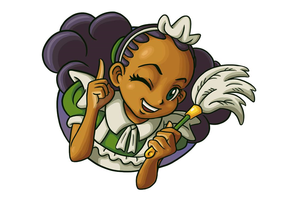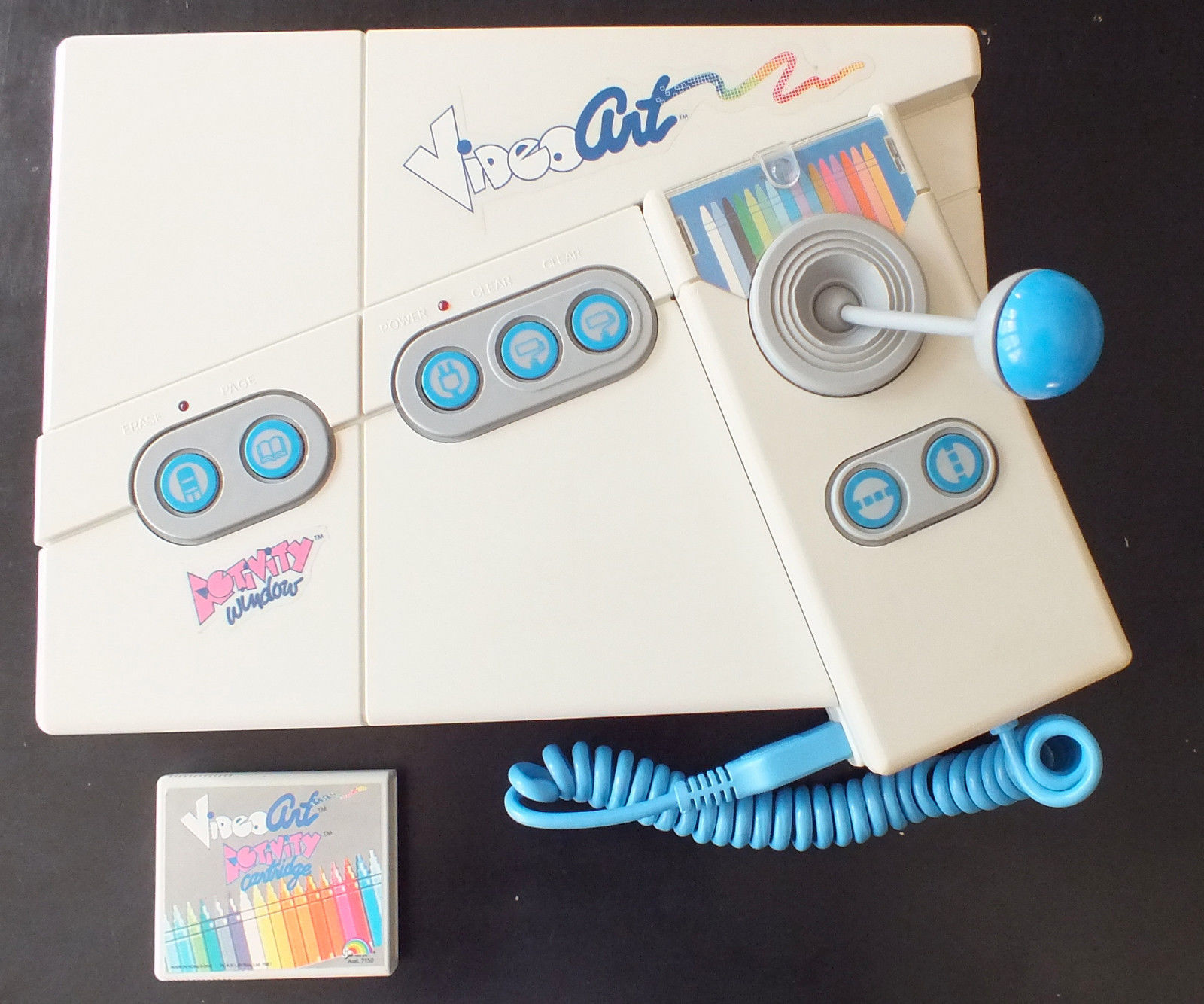LJN Video Art (found set of game cartridges for art console; 1987): Difference between revisions
No edit summary |
(I was not able to find a source for the 1985 release date. "The Siskel and Ebert 1987 Holiday Guide" suggests that it was actually released in 1987. Added references to the AVGN review and the Holiday Guide.) |
||
| Line 6: | Line 6: | ||
|status=<span style="color:orange;">'''Partially Found'''</span> | |status=<span style="color:orange;">'''Partially Found'''</span> | ||
}} | }} | ||
The LJN Video Art is an educational home video game console that was developed and manufactured by LJN Toys, Ltd.. The console was introduced in | The LJN Video Art is an educational home video game console that was developed and manufactured by LJN Toys, Ltd.. The console was introduced in 1987, but the exact release date is unknown. | ||
A single cartridge was included in the product, that being the ''Video Art Activity Cartridge''. It contains several wireframe drawings that can be colored, similar to a coloring book. Turning on the system without the cartridge inserted would give the user a blank screen which he/she could draw on. | A single cartridge was included in the product, that being the ''Video Art Activity Cartridge''. It contains several wireframe drawings that can be colored, similar to a coloring book. Turning on the system without the cartridge inserted would give the user a blank screen which he/she could draw on. | ||
'''''Other cartridges were made available for the system''''', however, they are incredibly rare and have yet to surface, physical or emulation. While the console itself (and the ''Activity Cartridge'') can be bought easily, neither the system nor any of the cartridges have been emulated so far. | '''''Other cartridges were made available for the system''''', however, they are incredibly rare and have yet to surface, physical or emulation. While the console itself (and the ''Activity Cartridge'') can be bought easily, neither the system nor any of the cartridges have been emulated so far. A complete list of games released, aside from the bundled ''Video Art Activity Cartridge'', can be found on a flier that was included with each of the game releases.<ref>[https://archive.org/details/ljnvideoartflier The LJN flier that shows the full list of games.] Retrieved 7 Oct '19</ref> | ||
==Premise== | ==Premise== | ||
Video Art was intended to compete against television instead of the mainstream game consoles at the time, such as the Nintendo Entertainment System and the Sega Master System. Functionality was similar to basic personal computer paint programs such as MacPaint and Microsoft Paint, and also offered games with a coloring book. | Video Art was intended to compete against television instead of the mainstream game consoles at the time, such as the Nintendo Entertainment System and the Sega Master System. Functionality was similar to basic personal computer paint programs such as MacPaint and Microsoft Paint, and also offered games with a coloring book. The console was largely forgotten until December 22nd, 2014, when an ''Angry Video Game Nerd'' episode covering the console was released as part of the show's ''12 Days of Shitsmas'' sub-series. | ||
The console used Twin-lead connectors with metal fork-shaped prongs, which are notoriously difficult to set up, as it required screwing them into your TV. The prongs had become outdated at the time, with its last use being in the late 1970s, long before the system was released. This also required the consumer to use an older TV to be able to use Video Art, as many new TVs did not have the correct attachments. Another flaw was the non-existent (though it did produce a static-like sound similar to white noise) background music. This meant nothing was there to listen to and keep the user occupied, aside from the games. The sound has been described as unpleasant to the ears. | The console used Twin-lead connectors with metal fork-shaped prongs, which are notoriously difficult to set up, as it required screwing them into your TV. The prongs had become outdated at the time, with its last use being in the late 1970s, long before the system was released. This also required the consumer to use an older TV to be able to use Video Art, as many new TVs did not have the correct attachments. Another flaw was the non-existent (though it did produce a static-like sound similar to white noise) background music. This meant nothing was there to listen to and keep the user occupied, aside from the games. The sound has been described as unpleasant to the ears.<ref name="AVGN">[https://www.youtube.com/watch?v=8-zEhhTqdvg AVGN Christmas special that demonstrated the connection method, audio, and controller for LJN Videoart.] Retrieved 7 Oct '19</ref> | ||
The system's joystick was also too stiff and had far too much travel to be able to draw with good precision. The top button would need to be depressed while simultaneously moving the joystick at the same time to draw. This made it difficult to move the joystick for precise drawing. A button on the console allowed the user to erase with the joystick instead of draw, and two buttons on the controller, one that would lock the cursor vertically, and the other horizontally. There were no tools the user could use, with drawing, erasing or changing the color using the controller the only possible options. Squeaking noises were also made when moving the joystick, which annoyed many reviewers. | The system's joystick was also too stiff and had far too much travel to be able to draw with good precision. The top button would need to be depressed while simultaneously moving the joystick at the same time to draw. This made it difficult to move the joystick for precise drawing. A button on the console allowed the user to erase with the joystick instead of draw, and two buttons on the controller, one that would lock the cursor vertically, and the other horizontally. There were no tools the user could use, with drawing, erasing or changing the color using the controller the only possible options. Squeaking noises were also made when moving the joystick, which annoyed many reviewers. <ref name="AVGN" /> | ||
Footage of the system has also resurfaced as part of Siskel and Ebert's 1987 Holiday Gift Guide. At the time, the two men expressed criticisms similar to the ones that AVGN would bring up decades later. Both of them state that they have trouble drawing accurately with the joystick, and they both did not recommend the product.<ref>[https://www.youtube.com/watch?v=6_u5d7xWZ-Q Siskel and Ebert reviewing various products in time for the 1987 Christmas Season.] Retrieved 7 Oct '19</ref> | |||
==Cartridges== | ==Cartridges== | ||
| Line 45: | Line 45: | ||
|On the Move||<span style="color:red;">''Lost''</span> | |On the Move||<span style="color:red;">''Lost''</span> | ||
|} | |} | ||
==Gallery== | |||
{{Video|perrow =2 | |||
|service1 =youtube | |||
|id1 =6_u5d7xWZ-Q | |||
|description1 = Siskel and Ebert's Christmas Guide 1987 (Courtesy of MattAKASchfiftyThree). | |||
|service2 =youtube | |||
|id2 =8-zEhhTqdvg | |||
|description2 = AVGN Christmas special featuring the LJN Videoart (Courtesy of Cinemassacre). | |||
}} | |||
==References== | |||
{{reflist}} | |||
[[Category:Lost video games]] | [[Category:Lost video games]] | ||
[[Category:Partially found media]] | [[Category:Partially found media]] | ||
Revision as of 14:01, 7 October 2019
The LJN Video Art is an educational home video game console that was developed and manufactured by LJN Toys, Ltd.. The console was introduced in 1987, but the exact release date is unknown.
A single cartridge was included in the product, that being the Video Art Activity Cartridge. It contains several wireframe drawings that can be colored, similar to a coloring book. Turning on the system without the cartridge inserted would give the user a blank screen which he/she could draw on.
Other cartridges were made available for the system, however, they are incredibly rare and have yet to surface, physical or emulation. While the console itself (and the Activity Cartridge) can be bought easily, neither the system nor any of the cartridges have been emulated so far. A complete list of games released, aside from the bundled Video Art Activity Cartridge, can be found on a flier that was included with each of the game releases.[1]
Premise
Video Art was intended to compete against television instead of the mainstream game consoles at the time, such as the Nintendo Entertainment System and the Sega Master System. Functionality was similar to basic personal computer paint programs such as MacPaint and Microsoft Paint, and also offered games with a coloring book. The console was largely forgotten until December 22nd, 2014, when an Angry Video Game Nerd episode covering the console was released as part of the show's 12 Days of Shitsmas sub-series.
The console used Twin-lead connectors with metal fork-shaped prongs, which are notoriously difficult to set up, as it required screwing them into your TV. The prongs had become outdated at the time, with its last use being in the late 1970s, long before the system was released. This also required the consumer to use an older TV to be able to use Video Art, as many new TVs did not have the correct attachments. Another flaw was the non-existent (though it did produce a static-like sound similar to white noise) background music. This meant nothing was there to listen to and keep the user occupied, aside from the games. The sound has been described as unpleasant to the ears.[2]
The system's joystick was also too stiff and had far too much travel to be able to draw with good precision. The top button would need to be depressed while simultaneously moving the joystick at the same time to draw. This made it difficult to move the joystick for precise drawing. A button on the console allowed the user to erase with the joystick instead of draw, and two buttons on the controller, one that would lock the cursor vertically, and the other horizontally. There were no tools the user could use, with drawing, erasing or changing the color using the controller the only possible options. Squeaking noises were also made when moving the joystick, which annoyed many reviewers. [2]
Footage of the system has also resurfaced as part of Siskel and Ebert's 1987 Holiday Gift Guide. At the time, the two men expressed criticisms similar to the ones that AVGN would bring up decades later. Both of them state that they have trouble drawing accurately with the joystick, and they both did not recommend the product.[3]
Cartridges
| Title | Status |
|---|---|
| Video Art Activity Cartridge | Found |
| A Trip To The Zoo | Lost |
| Disney Coloring Book | Lost |
| Disney Story Book | Lost |
| Looney Tunes | Lost |
| Marvel Super-Heroes | Lost |
| My Dream Day | Lost |
| My Favorite Doll | Lost |
| On the Move | Lost |
Gallery
References
- ↑ The LJN flier that shows the full list of games. Retrieved 7 Oct '19
- ↑ 2.0 2.1 AVGN Christmas special that demonstrated the connection method, audio, and controller for LJN Videoart. Retrieved 7 Oct '19
- ↑ Siskel and Ebert reviewing various products in time for the 1987 Christmas Season. Retrieved 7 Oct '19

